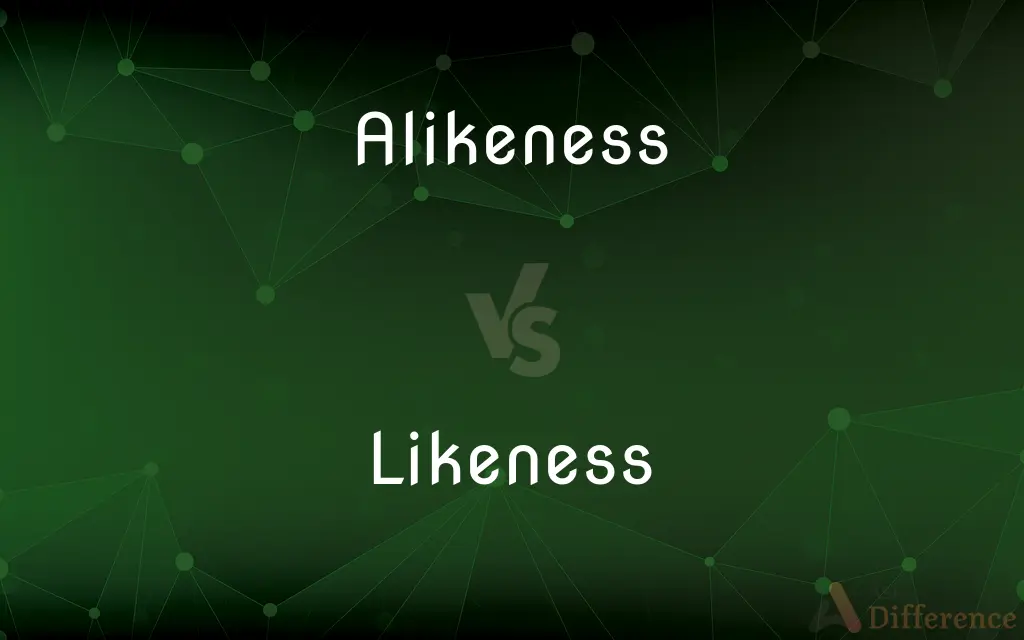Alikeness vs. Likeness — What's the Difference?
By Tayyaba Rehman & Fiza Rafique — Updated on March 19, 2024
Alikeness refers to a general state of being similar or comparable, often in abstract terms, while likeness emphasizes a more concrete or accurate resemblance, typically in appearance or form.

Difference Between Alikeness and Likeness
Table of Contents
ADVERTISEMENT
Key Differences
Alikeness implies a broader, sometimes more abstract similarity between things, suggesting they share certain qualities or characteristics without being identical. Likeness, however, conveys a closer, more specific similarity, often in physical appearance, suggesting a near or exact replication.
While alikeness can be used to describe similarities in concepts, feelings, or general attributes, likeness is more often used in contexts that involve visual or tangible resemblances, such as portraits or sculptures that capture the physical appearance of a subject. This distinction highlights how likeness is associated with more concrete comparisons.
In literary or metaphorical contexts, alikeness might be used to draw comparisons between abstract ideas or themes, suggesting a level of similarity in nature or essence. On the other hand, likeness is more likely to be used in descriptions that aim to create a vivid image or to emphasize the physical resemblance between things or people.
Alikeness can sometimes be more subjective, depending on the perception of shared qualities or characteristics, which might not be immediately apparent. Conversely, likeness usually involves more objective criteria, particularly in visual arts or when comparing physical features, where the resemblance can be more directly observed and assessed.
The usage of alikeness tends to be less common in everyday language, often appearing in more formal or philosophical discussions. Likeness, meanwhile, is more commonly used in everyday speech and writing, particularly when describing the resemblance between people, objects, or artistic representations.
ADVERTISEMENT
Comparison Chart
Definition
General state of being similar or comparable, often abstractly
Specific and accurate resemblance, often in appearance or form
Context
More abstract, used in comparing qualities or characteristics
More concrete, used in visual or tangible resemblances
Usage
Often in philosophical or abstract discussions
Common in everyday language and visual arts
Subjectivity
Can be more subjective, based on perceived similarities
More objective, based on direct observation of physical features
Common Associations
Concepts, feelings, general attributes
Physical appearance, visual arts, exact replicas
Compare with Definitions
Alikeness
A state of being similar in qualities or characteristics.
The alikeness of their interests led to a fast friendship.
Likeness
A close resemblance, particularly in appearance.
The portrait captured her likeness perfectly.
Alikeness
Can imply a connection based on shared attributes.
There's an alikeness between the two concepts that's hard to ignore.
Likeness
Used to describe a physical or visual similarity.
The twins' likeness often leads to confusion.
Alikeness
Used to describe comparability in abstract terms.
The alikeness of their philosophies is striking.
Likeness
Associated with visual arts and representations.
The artist is known for capturing the true likeness of his subjects.
Alikeness
Often found in more formal or philosophical texts.
The essay discusses the alikeness of different ethical theories.
Likeness
Implies a more concrete comparison than alikeness.
The sculpture is an exact likeness of the ancient artifact.
Alikeness
Indicates a general resemblance without exact replication.
Their strategies share an alikeness in approach.
Likeness
Common in everyday language to describe resemblances.
Their likeness to each other is uncanny.
Alikeness
Having close resemblance; similar
The twins are as alike as two peas in a pod. Friends are generally alike in background and tastes.
Likeness
The fact or quality of being alike; resemblance
Her likeness to him was astonishing
A family likeness can be seen in all the boys
Alikeness
In the same manner or to the same degree
They dress and walk alike.
Likeness
The state, quality, or fact of being like; resemblance.
Alikeness
(uncountable) The state or quality of being alike.
Likeness
A similar appearance; a semblance.
Alikeness
(countable) The result or product of being alike.
Likeness
A pictorial, graphic, or sculptured representation of something; an image.
Alikeness
Similarity in appearance or character or nature between persons or things;
Man created God in his own likeness
Likeness
The state or quality of being like or alike
Likeness
Appearance or form; guise.
A foe in the likeness of a friend
Likeness
That which closely resembles; a portrait.
How he looked, the likenesses of him which still remain enable us to imagine.
Likeness
To depict.
Likeness
The state or quality of being like; similitude; resemblance; similarity; as, the likeness of the one to the other is remarkable.
Likeness
Appearance or form; guise.
An enemy in the likeness of a friend.
Likeness
That which closely resembles; a portrait.
[How he looked] the likenesses of him which still remain enable us to imagine.
Likeness
A comparison; parable; proverb.
He said to them, Soothly ye shall say to me this likeness, Leech, heal thyself.
Likeness
Similarity in appearance or character or nature between persons or things;
Man created God in his own likeness
Likeness
Picture consisting of a graphic image of a person or thing
Common Curiosities
Is alikeness more subjective than likeness?
Yes, alikeness can be more subjective, relying on perceived similarities, whereas likeness often involves more objective, observable resemblances.
Can alikeness and likeness be used interchangeably?
While there might be contexts where they overlap, they are not fully interchangeable due to their different implications of generality and specificity.
What is the difference between alikeness and likeness?
Alikeness refers to a general or abstract similarity, whereas likeness implies a more specific and often visual resemblance.
How is likeness used in art?
In art, likeness refers to the accurate depiction of a subject's appearance, capturing their physical features in detail.
Can two things have alikeness without likeness?
Yes, two things can share general qualities or characteristics (alikeness) without having a specific or visual resemblance (likeness).
Does likeness always imply a visual resemblance?
Likeness often implies a visual resemblance but can also refer to other forms of close replication, such as in behavior or mannerisms, though less commonly.
Why is alikeness less common in everyday language?
Alikeness tends to be less common due to its more abstract and formal connotations, making it more suited to philosophical or scholarly discussions.
Is likeness important in portrait art?
Yes, capturing the likeness of the subject is crucial in portrait art, as it involves creating a recognizable representation of the person's appearance.
How does alikeness contribute to metaphorical language?
Alikeness can be used metaphorically to draw abstract comparisons between concepts, ideas, or themes, highlighting their shared qualities.
Can the likeness be quantified or measured?
While somewhat subjective, the likeness can be more readily assessed based on the accuracy of physical resemblances, making it somewhat measurable.
Share Your Discovery

Previous Comparison
Webtoon vs. Manhwa
Next Comparison
River vs. BeckAuthor Spotlight
Written by
Tayyaba RehmanTayyaba Rehman is a distinguished writer, currently serving as a primary contributor to askdifference.com. As a researcher in semantics and etymology, Tayyaba's passion for the complexity of languages and their distinctions has found a perfect home on the platform. Tayyaba delves into the intricacies of language, distinguishing between commonly confused words and phrases, thereby providing clarity for readers worldwide.
Co-written by
Fiza RafiqueFiza Rafique is a skilled content writer at AskDifference.com, where she meticulously refines and enhances written pieces. Drawing from her vast editorial expertise, Fiza ensures clarity, accuracy, and precision in every article. Passionate about language, she continually seeks to elevate the quality of content for readers worldwide.














































